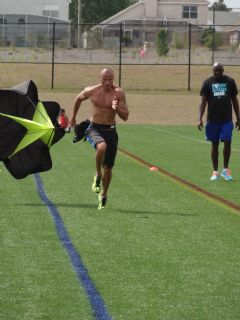This warm weather camp, I am working exclusively with Lloyd's (Cowan) group as opposed to a mix of athletes trained by a variety of coaches. The group are made up of 400m runners (including Chrissy Ohuruogu), sprinters (including Bianca Williams) & sprint hurdlers (including Andy Turner), so there is a real vibrancy to the training, with seasoned pros working alongside several young pretenders. Our main base is the ESPN Wide World of Sports Complex at Disney, which is home to Brooks Johnson's group, which includes USA hurdler David Oliver & at this time of year the facility is buzzing with baseball spring training camps, lacrosse camps, soccer camps & American football training camps all taking place alongside the track & field sessions.
This afternoon, whilst everyone rests up from the morning's exertions, I am catching up on some reading & have been looking at an article published in the Journal of Physiology by Louise Burke's research group at RMIT in Australia, lead author Areta (2013), that investigates the optimal amount of post-resistance training ingestion of protein to achieve maximal myofibrillar protein synthesis.
24 healthy trained athletes were assigned to three experimental groups, with each undertaking a bout of resistance exercise followed by ingestion of 80g of whey protein over the following 12 hour recovery period. The first group (n=8) ingested 8 x 10g every 1.5 hours (PULSE), the second (n=8) consumed 4 x 20g every 3 hours (INTERMEDIATE) & the third group (n=8) took 2 x 40g every 6 hours (BOLUS). Muscle biopsies were then obtained at rest & after 1, 4, 6, 7 & 12 hours post-exercise bout, with myofibrillar protein synthesis (L-[ring-13C6] phenylalanine), muscle mRNA abundance & cell signalling being assessed.
Results suggested that the INTERMEDIATE method of ingestion was superior to either the PULSE or BOLUS when promoting anabolic responses in skeletal muscle & the authors concluded that the approach subsequently "has potential to maximise the outcomes of resistance training for attaining peak muscle mass".
To review the abstract click on the link below:
Right, enough intellectual stimulation for the day, I'm needing to cool off in the pool!

